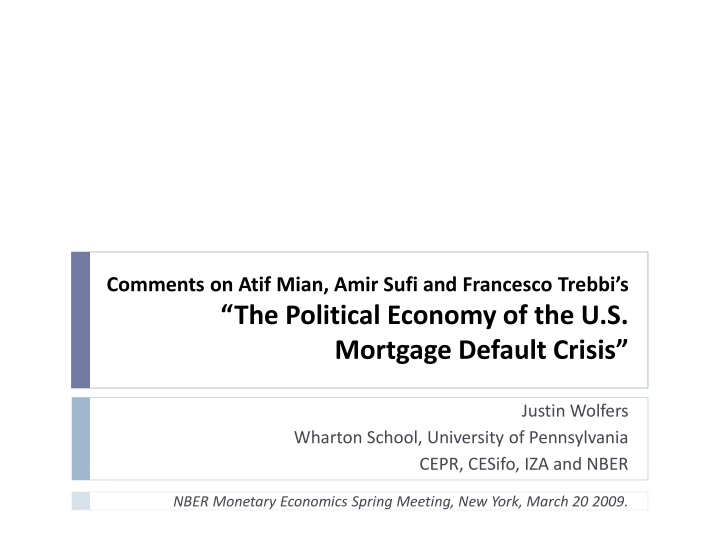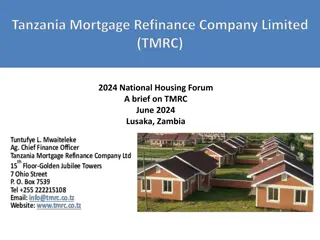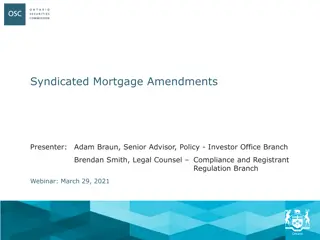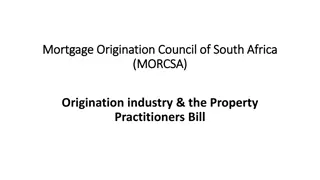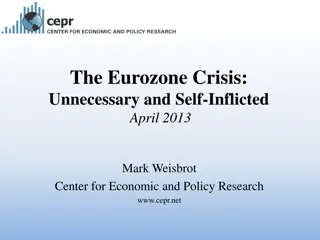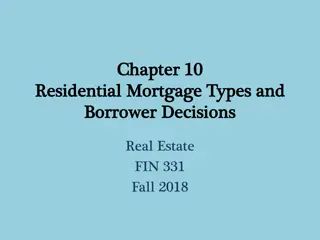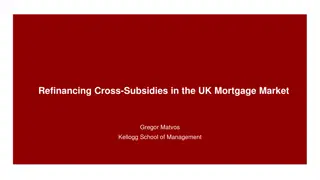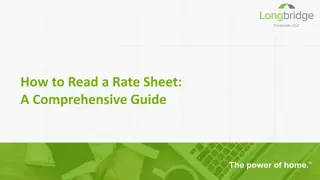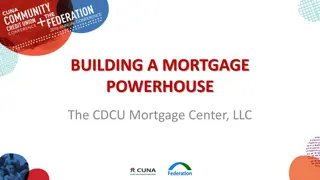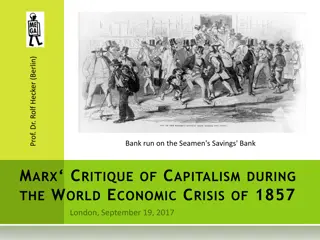Analysis of Political and Economic Factors in the U.S. Mortgage Default Crisis
This research paper by Justin Wolfers delves into the correlations between voting patterns, constituent interests, and economic conditions amidst the U.S. Mortgage Default Crisis. It highlights how legislators respond to constituent interests, including voting for bills that impact mortgage default rates and FOMC voting patterns based on regional economic factors.
Download Presentation

Please find below an Image/Link to download the presentation.
The content on the website is provided AS IS for your information and personal use only. It may not be sold, licensed, or shared on other websites without obtaining consent from the author.If you encounter any issues during the download, it is possible that the publisher has removed the file from their server.
You are allowed to download the files provided on this website for personal or commercial use, subject to the condition that they are used lawfully. All files are the property of their respective owners.
The content on the website is provided AS IS for your information and personal use only. It may not be sold, licensed, or shared on other websites without obtaining consent from the author.
E N D
Presentation Transcript
Comments on Atif Mian, Amir Sufi and Francesco Trebbis The Political Economy of the U.S. Mortgage Default Crisis Justin Wolfers Wharton School, University of Pennsylvania CEPR, CESifo, IZA and NBER NBER Monetary Economics Spring Meeting, New York, March 20 2009.
What this paper does Provide evidence of robust correlations between Voting to support Fannie and Freddie (AHRFPA) and: Mortgage default rate in your district ( Constituent interests ) Particularly in sympathetic zip codes ( Dual constituency ) Strongest in competitive races 1. Voting for TARP (Emergency Economic Stabilization Act) and: Campaign contributions from the financial sector 2. These correlations hold, when controlling for: Legislator s voting record (ideology) Legislator characteristics: finance committee, experience Electoral math: Vote margin in 06; Presidential vote share in 04 District demographics in 2000: race, ethnicity, education, income Justin Wolfers, Comments on The Political Economy of the Mortgage Default Crisis 2
Finding #1: Voting for mortgage reform correlated with default rates This paper argues Politicians are responsive to constituent interests Voting for a bill that redistributes toward their constituents Alternatives Information differences Politicians are responsive to perceived macro conditions And what is happening in your district shapes your beliefs Politicians are responsive to economic conditions generally (versus mortgage defaults) The only measure of variation in economic conditions is the mortgage default rate (and sometimes, non-mortgage default rate) They are voting to do something (versus redistribute) Justin Wolfers, Comments on The Political Economy of the Mortgage Default Crisis 3
Explaining FOMC Votes 68% of the dovish dissents were from regions with unemploy ment above the national average 74% of the hawkish dissents were from regions with unemploy ment below the national average Justin Wolfers, Comments on The Political Economy of the Mortgage Default Crisis Source: Ellen Meade & Nathan Sheets (2005), Regional Influences on FOMC Voting Patterns, JMCB 37(4). 4
Figure 2 Mortgage Defaults and Voting for Mortgage Help AHRFPA '08 vote and mortgage default rate in Republican districts 1 .8 Propensity to vote in favor PDF of x (dashed line) .6 .4 .2 0 0 .05 .1 .15 Mortgage default rate Justin Wolfers, Comments on The Political Economy of the Mortgage Default Crisis 5
Figure 2 AHRFPA '08 vote and mortgage default rate in Republican districts y = -0.14 +6.7 x (t=4.3) 1 .8 Propensity to vote in favor PDF of x (dashed line) .6 .4 .2 0 0 .05 .1 .15 Mortgage default rate Justin Wolfers, Comments on The Political Economy of the Mortgage Default Crisis 6
Figure 2 Plus distn AHRFPA '08 vote and mortgage default rate in Republican districts y = -0.14 +6.7 x (t=4.3) 1 .8 Propensity to vote in favor PDF of x (dashed line) .6 .4 .2 0 0 .05 .1 .15 Mortgage default rate Justin Wolfers, Comments on The Political Economy of the Mortgage Default Crisis 7
Figure 2 Bottom 95% AHRFPA '08 vote and mortgage default rate in Republican districts y = -0.14 +6.7 x (t=4.3) Dropping the extreme 5% of default rates y = 0.04 +3.1 x (t=1.4) 1 .8 Propensity to vote in favor PDF of x (dashed line) .6 .4 The 5% most affected districts: -5 districts in southern CA -4 districts in coastal FL .2 0 0 .05 .1 .15 Mortgage default rate Justin Wolfers, Comments on The Political Economy of the Mortgage Default Crisis 8
Finding #1: Voting for mortgage reform correlated with default rates This paper argues Politicians are responsive to constituent interests Voting for a bill that redistributes toward their constituents Alternatives Information differences Politicians are responsive to perceived macro conditions And what is happening in your district shapes your beliefs Politicians are responsive to economic conditions generally (versus mortgage defaults) The only measure of variation in economic conditions is the mortgage default rate (and sometimes, non-mortgage default rate) They are voting to do something (versus redistribute) Justin Wolfers, Comments on The Political Economy of the Mortgage Default Crisis 9
A Placebo: HR-1456 HR-1456: To impose an additional tax on bonuses received from certain TARP recipients. Taxes AIG bonus recipients at 90% Passed the House yesterday: 328-93 Voting for this bill: Unrelated to constituent interests No distinct redistribution to default-prone parts of the country Consistent with an urge to do something Justin Wolfers, Comments on The Political Economy of the Mortgage Default Crisis 10
AIG Vote Falsification exercise HR-1586 vote and mortgage default rate in Republican districts y =1.1 21*x + 151*x2 (t=2.3) (t=2.4) Re-run results on today s AIG tax bill HR 1 Propensity to vote in favor .8 .6 .4 .2 0 0 .05 .1 .15 Mortgage default rate Justin Wolfers, Comments on The Political Economy of the Mortgage Default Crisis 11
Finding #2: TARP votes and campaign donations are correlated Broader question: What do campaign donations do? This paper argues: Buying votes Politicians are responsive to special interests , voting for a bill that redistributes to campaign donors Implication: Target those legislators who will be pivotal Alternative explanation: Buying elections Campaign donors target politicians who are already sympathetic to their message, helping them get re-elected Implication: Target those legislators in close races Justin Wolfers, Comments on The Political Economy of the Mortgage Default Crisis 12
Do Finance Sector Campaign Donations Target Pivotal Legislators? Do finance industry donations target pivotal lawmakers? Probability legislator is pivotal on TARP bill, and finance sector donations Identifying pivotal lawmakers |Probability of voting yea 0.5| Probit: I(Vote yea ) = f(legislator ideology, finance industry employees, %earning >$200k, district-level demographics) 12 I(Vote yea ) = f(legislator ideology, finance industry employees, %earning >$200k, district-level demographics) 11.8 1. Log financial industry contributions 11.6 PDF of x 11.4 11.2 11 0 .2 .4 .6 .8 1 Predicted probability of voting in favor of TARP Justin Wolfers, Comments on The Political Economy of the Mortgage Default Crisis 13
Do Finance Sector Campaign Donations Target Pivotal Legislators? Do Campaign Donations Target Pivotal Lawmakers? Probably legislator is pivotal on TARP bill, and finance sector donations 12 11.8 Log financial industry contributions PDF of x (dashed line) 11.6 11.4 11.2 11 0 .2 .4 .6 .8 1 Predicted probability of voting in favor of TARP Justin Wolfers, Comments on The Political Economy of the Mortgage Default Crisis 14
Do Finance Sector Campaign Donations Target Pivotal Legislators? Do campaign donations target pivotal voters? Probably legislator is pivotal on TARP bill, and finance sector donations y = 11.6 0.8*|x-.5| (t=2.2) 12 11.8 Log financial industry contributions PDF of x (dashed line) 11.6 11.4 11.2 11 0 .2 .4 .6 .8 1 Predicted probability of voting in favor of TARP Justin Wolfers, Comments on The Political Economy of the Mortgage Default Crisis 15
Finding #2: TARP votes and campaign donations are correlated Broader question: What do campaign donations do? This paper argues: Buying votes Politicians are responsive to special interests , voting for a bill that redistributes to campaign donors Implication: Target those legislators who will be pivotal Identifying pivotal voters |Probability of voting yea 0.5| Log(finance sector donations) = 11.6 0.8*|predicted probability-0.5| Pivotal voters: Switched their votes between the two TARP votes Log(finance sector donations) = 11.5 0.08*switcher (t=0.6) Alternative explanation: Buying elections Campaign donors target politicians who are already sympathetic to their message, helping them get re-elected Implication: Target those legislators in close races (t=2.2) Justin Wolfers, Comments on The Political Economy of the Mortgage Default Crisis 16
Finding #2: TARP votes and campaign donations are correlated Broader question: What do campaign donations do? This paper argues: Buying votes Politicians are responsive to special interests , voting for a bill that redistributes to campaign donors Implication: Target those legislators who will be pivotal Identifying pivotal voters |Probability of voting yea 0.5| Log(finance sector donations) = 11.6 0.8*|predicted probability-0.5| Pivotal voters: Switched their votes between the two TARP votes Log(finance sector donations) = 11.5 0.08*switcher (t=0.6) Alternative explanation: Buying elections Campaign donors target politicians who are already sympathetic to their message, helping them get re-elected Implication: Target those legislators in close races (t=2.2) Justin Wolfers, Comments on The Political Economy of the Mortgage Default Crisis 17
Do Finance Sector Campaign Donations Target Close Races? Do finance industry donations target pivotal lawmakers? 2006 election margins, and finance sector donations Identifying pivotal lawmakers |Probability of voting yea 0.5| Probit: I(Vote yea ) = f(legislator ideology, finance industry employees, %earning >$200k, district-level demographics) Regress donations on predicted voting behavior: Log(finance sector donations) = 11.6 0.8*|predicted probability-0.5| (t=2.2) Legislators who actually changed their minds between the two TARP votes Yields 59 legislators who are pivotal Log(financial industry contributions) = 11.5 0.08*Switcher (t=0.6) 10.5 12.5 1. Log financial industry contributions 12 2. 11.5 11 -100 -50 0 50 100 2006 Election Margins: Democrat vote share - Republican vote share Justin Wolfers, Comments on The Political Economy of the Mortgage Default Crisis 18
What this paper does Provide evidence of robust correlations between 1. Voting to support Fannie and Freddie (AHRFPA) and: Mortgage default rate in your district ( Constituent interests ) Particularly in sympathetic zip codes ( Dual constituency ) Strongest in competitive races Does this reflect constituent interests OR differences in beliefs about the state of the economy? Voting for TARP (Emergency Economic Stabilization Act) and: Campaign contributions from the financial sector Does this reflect special interests buying votes OR special interests funding legislators with sympathetic agendas? 2. These correlations hold, when controlling for: Legislator s voting record (ideology) Legislator characteristics: finance committee, experience Electoral math: Vote margin in 06; Presidential vote share in 04 District demographics in 2000: race, ethnicity, education, income Justin Wolfers, Comments on The Political Economy of the Mortgage Default Crisis 19
Whats left? Quibble An unusual solution to multicollinearity Puzzle Why do legislators in safe districts respond to constituent interests at all? Big issue Lucas critique / strategic voting / external validity Estimating voting behavior when non-pivotal legislator s voting behavior when pivotal Are we learning about political posturing, or policy preferences? Suggestions Statistical issues: Expand set of placebo regressions Why not gather data on 100 other pieces of legislation? Yields the sampling distribution of the correlation between mortgage defaults and legislator votes Strategic voting: Exploit information on order of votes Justin Wolfers, Comments on The Political Economy of the Mortgage Default Crisis 20
A unique solution to multicollinearity (micronumerosity) Their solution : Drop half the sample The problem: Difficult to distinguish which variable matters Justin Wolfers, Comments on The Political Economy of the Mortgage Default Crisis 21
Whats left? Quibble An unusual solution to multicollinearity Puzzle Why do legislators in safe districts respond to constituent interests at all? Big issue Lucas critique / strategic voting / external validity Estimating voting behavior when non-pivotal legislator s voting behavior when pivotal Are we learning about political posturing, or policy preferences? Suggestions Statistical issues: Expand set of placebo regressions Why not gather data on 100 other pieces of legislation? Yields the sampling distribution of the correlation between mortgage defaults and legislator votes Strategic voting: Exploit information on order of votes Justin Wolfers, Comments on The Political Economy of the Mortgage Default Crisis 22
Justin Wolfers, Comments on The Political Economy of the Mortgage Default Crisis 23
Politics affected voting on the bailout Justin Wolfers, Comments on The Political Economy of the Mortgage Default Crisis 24
